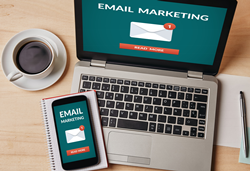How to Navigate Email Marketing’s New Rules, Pitfalls in a Pandemic World
Email marketing has long been an effective way for B2B marketers to reach customers, but COVID-19 made email marketing critical as other channels are no longer effective. Higher volumes of emails mean greater risks for blacklisting and other pitfalls, especially for the inexperienced as Sky Cassidy, CEO of Mountaintop Data, explains.

The nature of email marketing has shifted as a result of COVID-19, and it’s critical that marketers stay up to speed. With more people transitioning to remote work, other mediums such as phone and physical mail have been rendered less effective. But the higher volume of marketing emails saturating inboxes also presents a challenge to those who are less experienced with email marketing—how to beat out the competition and make sure their email gets the attention it deserves. “There are multiple forces working simultaneously,” says Sky Cassidy, CEO of MountainTop Data. “On the one hand, people are going to be emailing more. But on the other hand, more email means more friction, which means you’re going to have more issues with email accounts.”
While a recent study revealed that users opened COVID-19 related emails 30 percent more often than other email campaigns, this increase in volume also brought a higher number of complaints.(1) Customers isolated at home due to COVID-19 lockdowns led to an increase in ecommerce and higher volumes of emails. Email providers responded to this increase in volume by changing the rules pertaining to the filtering and spam classification of the emails. More emails were likely to end up in spam folders or undelivered, and senders were more likely to be blacklisted. Consequently, this combination of factors meant customers were less likely to open emails.
While the pandemic played a role on the changes that have occurred with email marketing, Cassidy points out that another cause for confusion was the lack of set rules for email marketing. To counteract this, he suggests B2B marketers use their instincts based on the marketing intelligence they have gathered about their customers. “You must go where your audience is and where they’re most likely to be receptive. In marketing, you’re constantly experimenting,” says Cassidy “For example, you may notice zero responses from physical mailers and then conclude that these particular customers you were trying to reach are not in the office. So, you must find the next most effective way to reach them.”
The most common pitfalls that inexperienced marketers tend to fall victim to nowadays include blacklisting, outdated and incomplete information, damaged reputation due to higher email bounce rates, and wasted time and money. Cassidy also points out another major pitfall he has seen damaging email marketing efforts: using newsletter platforms such as Mailchimp and Constant Contact to send cold emails. While these platforms are very useful, they were not designed for sending cold emails to bulk lists of contacts that have been purchased or haven’t previously engaged with your company. “People don’t realize you can’t just load 20,000 emails you purchased into those platforms and send them, [the newsletter platforms] frown on that,” says Cassidy.
Cassidy points out that in B2B marketing it’s often necessary to have two or even three different email channels. “First you have your sales and engagement platforms, the individual salespeople sending individual emails, and then an automated version of that with these platforms. Then you have your marketing newsletter style, direct marketing to existing opt-in people, and finally your cold email channel,” explains Cassidy.
So, how can novice email marketers avoid the other pitfalls and engage in this advertising medium more effectively? Besides making sure to use the right email platform for the right purpose, it’s also critical that marketers ensure they have clean, accurate, and up-to-date data. To achieve this, Cassidy suggests creating a “hibernation list” to keep track of emails that are unresponsive for a long period of time. And when it comes to outdated emails, not to make the common mistake of assuming that this problem is evenly distributed throughout your data. Cassidy points out that this is likely not the case if you consider that the turnover rate of CEOs, for example, is much lower than low-level IT people in an organization, or CMOs who have an average turnover rate of less than two years. As a result, people end up getting rid of a lot of good, useful data.(2)
For email marketing to be effective, marketers must know their client and their particular segment of the audience, says Cassidy. The lack of social interaction that has plagued the world since the COVID-19 lockdowns started has led people to have stronger desires and expectations for personal connection from businesses.(3) Marketers must understand how the audience thinks and feels, and what particular value the product holds for them. Then they can tailor emails and subject lines based on specific client insights, making it more likely to grab attention. Over time, businesses can form strong bonds with customers and improve their reputations, which makes finalizing deals more likely. And for cold emails, Cassidy suggests keeping them “short, catchy, and to-the-point, like a billboard.” He points out that the shorter the message is, the more likely it is to be absorbed and retained by your audience.
Finally, when it comes to avoiding common email marketing pitfalls, it’s critical to ensure you have the right keywords and attributes that will make your email appear authentic, and less likely to be marked as spam. Some of the surefire ways to get your emails blacklisted include putting a large amount of text in capital letters, using words like “free” or “discount” too frequently, or putting these terms in the email’s subject line.
While there is likely to be a shift at some point back to other mediums of marketing (such as phone and physical mail), most of these changes in email marketing are likely to stay, according to Cassidy. “Once we break the seal and everybody’s working from home, it’s not going to go back to everybody in the office.” However, it’s important marketers continue to pay attention to where their audience is and where they are the most receptive, as this can change depending on factors such as business size, industry, or niche. Cassidy says there have been changes companies are seeing as necessary to deliver the most accurate and useful data, such as developing a method to flag remote workers, so marketers don’t waste time and money sending them physical mailers.
The good news, according to Cassidy, is that despite the pandemic, doing business is moving forward, albeit with some slight adjustments. And now that digital marketers have endured the growing pains of these recent changes, they can reap the benefits. “People will probably continue to do more email marketing than they ever did before, because now they’ve learned how to do it properly. They’ve gotten blacklisted, fixed it, and are now doing it the right way.”
About MountainTop Data
MountainTop Data, headquartered in Los Angeles, CA, has been providing data services for B2B marketing for almost two decades. With an unrelenting commitment to quality, they were the first company to guarantee the accuracy of their licensed data and business emails. They provide marketing lists, data cleaning, data appending and data maintenance services. Their data services have been used by some of the world’s biggest brands across a multitude of various industries from multi-national telecommunication companies to office technology, to PR firms and more. For more information visit: https://www.mountaintopdata.com.
1. Afschrift, Marie. “Corona Has Changed Email Marketing.” Artegic, March 1 2021. artegic.com/blog/corona-has-changed-email-marketing/
2. Olenski, Steve. “CMO Turnover Highest In C-Suite But the Reasons Why May Surprise You.” The CMO Whisperer. cmo-whisperer.com/cmo-turnover-highest-in-c-suite-but-the-reasons-why-may-surprise-you/
3. Rotem, Gal. “How to Transform Your Email Marketing as the Pandemic Continues.” Inc, 2021. inc.com/rotem-gal/how-to-transform-your-email-marketing-as-pandemic-continues.html
Contact Author
KARLA JO HELMS
JOTO PR Disruptors(TM)
727-777-4619


